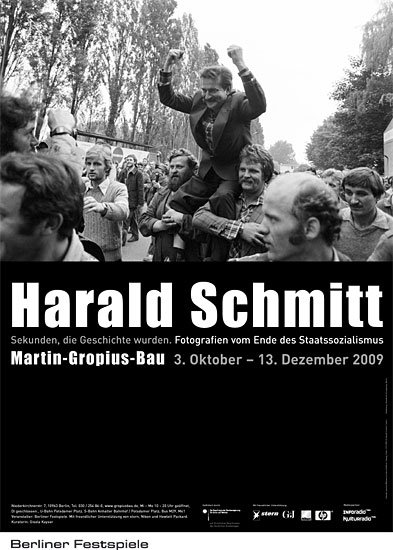Harald Schmitt
dal 2/10/2009 al 11/12/2009
Segnalato da
2/10/2009
Harald Schmitt
Martin Gropius Bau, Berlin
On show a total of 120 photographs with political and social themes. Most of them were taken in the former GDR, Soviet Union, communist Czechoslovakia, Poland, Latvia, Lithuania and China. Up until the 1990s the countries of Eastern Europe resembled a massive monolithic bloc. They were all subjected to the supremacy of the Soviet Union, forced into a military alliance, governed by similar political casts, dominated by a single ideology, and harassed by censorship.

Curated by Gisela Kayser
In autumn 2009 the Martin-Gropius-Bau will be mounting the first exhibition of the impressive work of the press photographer Harald Schmitt. A total of 120 photographs will be shown with political and social themes. Most of them were taken in the former GDR, Soviet Union, communist Czechoslovakia, Poland, Latvia, Lithuania and China.
Up until the 1990s the countries of Eastern Europe resembled a massive monolithic bloc. They were all subjected to the supremacy of the Soviet Union, forced into a military alliance, governed by similar political casts, dominated by a single ideology, and harassed by censorship. Ultimately, however, this mighty empire was shaken by eruptions that spread from one location to another, finally leading to the erosion of the entire Eastern bloc.
Photos of these upheavals were sought after in the West, but hard to get. The most impressive ones appeared in stern. Many of them came from Harald Schmitt. There was hardly a press photographer in the 1990s who was closer to what was happening, whether It was the big displays put on by the rulers or the first stirrings of resistance. Schmitt’s images of people living under state socialism and caught up in the scenes of upheaval record the great changes of that period. Again and again he captures the moment that becomes history.
Born on 2 March 1948 in Hausen/Mayen near Koblenz in the Rhineland-Palatinate, Harald Schmitt trained as a photographer before getting a job on the Trierische Landeszeitung. After that he worked for three years as a sports photographer for Dieter Frinke in Munich up until the 1972 Olympic Games in Munich. That same year he switched to the Sven Simon Photo Agency in Bonn and began to cover political and economic stories.
In 1974 the photographer went to Paris and Nice for a year, photographing actors on and off the set, before returning to his old agency in Bonn. Here he concentrated more on his own projects, such as the Carter/Ford presidential race in the U.S.; strikes in the U.K.; the establishment of the Socialist International in Spain, Italy and Portugal; and combat zones in Vietnam, Cambodia, Rhodesia, South-West Africa and Ireland. In 1977 Schmitt joined the staff of stern as a press photographer and spent six years as its accredited photographer in East Berlin. During this time he accompanied Erich Honecker to Japan and Zambia and covered the GDR’s socialist neighbours. In 1983 his visa was not renewed by the GDR government.
Harald Schmitt has travelled in over 110 countries and covered a wide variety of stories. His numerous distinctions include six World Press Photo Awards. Today Harald Schmitt is based in Hamburg, where he is still on the staff of Stern.
In the commentaries accompanying the exhibition his colleague, stern author Peter Sandmeyer, explains the historical context and tells the stories behind the pictures.
Organizer
Berliner Festspiele. With the kindl support of stern, Nikon and Hewlett Packard.
Media Partners rbb Inforadio, rbb Kulturradio
In autumn 2009 the Martin-Gropius-Bau will be mounting the first exhibition of the impressive work of the press photographer Harald Schmitt. A total of 120 photographs will be shown with political and social themes. Most of them were taken in the former GDR, Soviet Union, communist Czechoslovakia, Poland, Latvia, Lithuania and China.
Press contact:
Marie Skov Tel: (49-30)25486-236, Fax: (49-30)25486-235 Email: presse@gropiusbau.de
Opening 3 October 2009
Martin Gropius Bau
Niederkirchnerstrasse 7, Berlin
Opening Hours: Wednesday to Monday 10-20 hrs, Tuesday closed
free admission



